- Home
- Before & After
- Cataract Before & After Pictures
Cataract Before & After Pictures in Los Angeles
What is Cataract Surgery?
Cataract surgery is a procedure to remove the cloudy lens (a cataract) of your eye and replace it with an artificial one. This surgery restores clear vision quickly and painlessly. After surgery, you'll likely notice a significant improvement in your ability to see clearly.
-
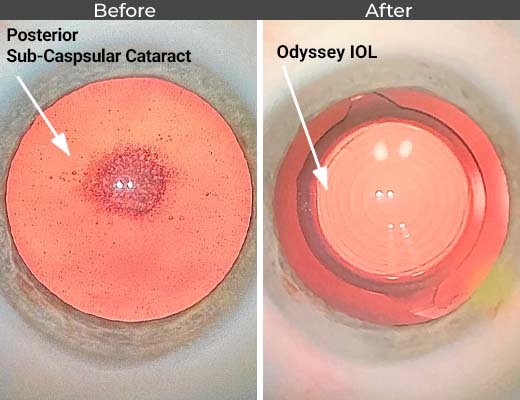
Premium cataract surgery with the Odyssey lens
Premium Cataract Surgery With The Odyssey Lens
Odyssey lens implanted in a 42 year old male hx of multiple myeloma with prolonged steroid use. He had a PSC cataract.
-
.jpg)
Envy IOL Post Odyssey Lens
Envy IOL Post Odyssey Lens
A 49-year-old ex-boxer and fireman with post-traumatic cataracts, the enVista Envy lens was selected due to the shape of his eyes and his desire to minimize nighttime glare while driving the fire truck.
-

Envista Envy with LRI Cataract and RLE Surgery
Envista Envy with LRI Cataract and RLE Surgery
A 64-year-old male who had several forms of early lens pacification: Nuclear Sclerosis NS, mild Oil Droplet, and Posterior Sub-Capsular (PSC), coupled with Farsightedness and Astigmatism combined to compromise his daily visual quality and hampering his profession (as a Pilot).
Based upon the shape of his cornea and his pupil diameters in bright light, a darkened environment, and pitch black lighting, as well as his lifestyle demands, our premium IOL selection algorithm recommended.
The enVista Envy lens is to be implanted in his right (affected, above the eye). The Ora Intraoperative Aberrometer further informed our treatment by pinpointing his astigmatism amount and orientation.
We performed a Limbal Relaxing Incision (arrow points to three ink markings, centered at 60°axis) because his astigmatism was below the level treated by the toric IOLs.
Based on his great satisfaction with his right eye's visual improvement, he then underwent a Refractive Lens Exchange (RLE) in his non-cataractous left eye (which had farsightedness and astigmatism with no lens opacities). RLE surgery is identical to Cataract surgery and aims to provide crisp and clear vision without glasses (without an actual cataract).
-
.jpg)
Bausch + Lomb enVista Envy Toric IOL
Bausch + Lomb enVista Envy Toric IOL
With a Nuclear Sclerotic Cataract on this patient’s left eye, our IOL selection algorithms indicated that he should receive the Bausch & Lomb enVista Envy Toric premium IOL. This lens is designed to address his high degree of nearsightedness.
-
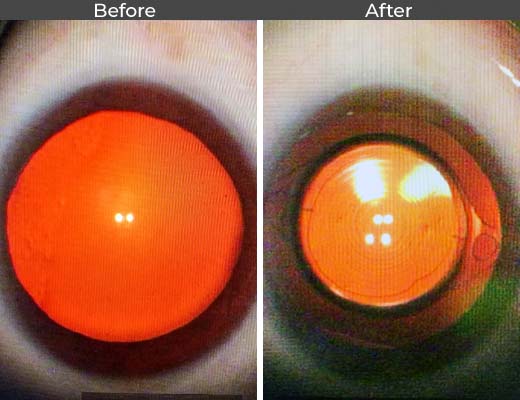
Bausch & Lomb EnVista Envy Toric IOL
Bausch & Lomb EnVista Envy Toric IOL
A Cataract with high Astigmatism in this patient’s right eye was treated with the Bausch & Lomb enVista Envy Toric lens. When aligned with the Ora aberometer’s identified axis of the eye’s astigmatism, these hash marks neutralize that Astigmatism.
-
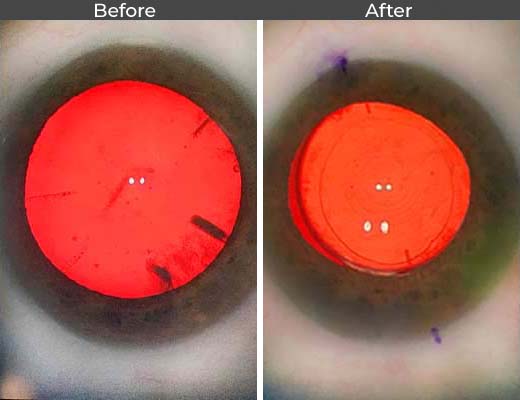
EnVista Envy Cortical Spoking
EnVista Envy Cortical Spoking
A 59-year-old female with a history of chronic contact lens wear since childhood had Lasik to treat her farsightedness fifteen years ago and had recently developed cataracts. She was treated with the Envista Envy Toric IOL based on her eye anatomy and astigmatism.
Note the slight misalignment of the IOL hash marks (arrows) and the initial corneal markings (other arrows), as once the astigmatism orientation is identified by the Ora Aberrometer (blue markings) and the lens is inserted. Repeat measurements are taken, and lens position is further refined to eliminate any remaining measure astigmatism. Her astigmatism was eliminated, and she achieved 20/20 vision near and distant.
-
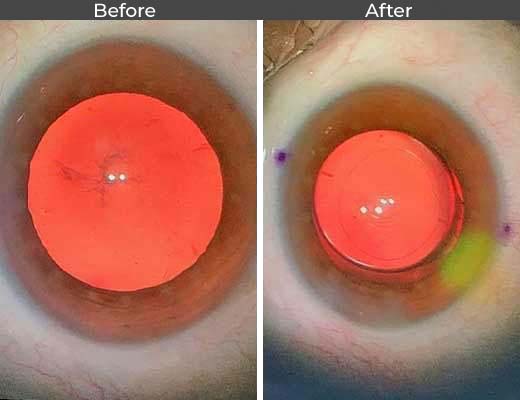
EnVista IOL Revision Surgery
Bausch + Lomb EnVista IOL Revision Surgery
A 53-year-old pilot with mild farsightedness and moderate astigmatism developed dry eye symptoms, making contact lenses hard to wear. Testing showed that Refractive Lens Exchange was better than MonoVision Lasik, as he preferred binocular vision for near and distance.
Based on his pupil size in various lighting conditions, corneal curvature, and lifestyle needs, our IOL selection algorithm informed that a Refractive Lens Exchange using the Envy Lens would provide the most optimal result.
The Toric version was implanted (to correct astigmatism), with the lens orientation refined during surgery using the Ora Aberrometer to determine the exact axis of astigmatism (purple markings) and the lens then precisely aligned (hash marks on lens).
-
.jpg)
ClearView IOL Lens Revision with New enVista Envy Lens
ClearView IOL Lens Revision with New enVista Envy Lens
A 72-year-old female had received Lasik for farsightedness (hyperopia) 26 years earlier and did well. Three years ago, she developed a cataract and was treated, receiving the SBL-3 (ClearView) IOL lens, which serves as a bifocal. “She liked her near vision but experienced blurry distance vision, day and night. She was referred to the Assil Gaur Eye Institute for a lens exchange.
Because of her relatively large daytime pupil diameter, steep corneal curvature (following hyperopic Lasik), and desire for minimal glare, our algorithm identified the Bausch and Lomb Envista Envy lens (an IOL lens designed to see at all distances and light settings) as the ideal lens for her. Her vision is now 20/20 at near and distance in that eye, and she reports excellent visual clarity without any halos or glare issues.
-
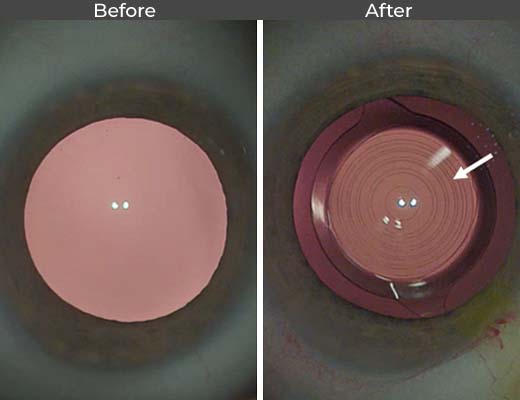
Refractive Lens Exchange with Odyssey Premium Lens
Refractive Lens Exchange with Odyssey Premium Lens
This 49-year-old nurse noticed her distance and near vision deteriorating due to progressive farsightedness (hyperopia) and loss of near-focusing ability (presbyopia). She wanted to be free of glasses and did not like the vision quality when wearing mono-vision contact lenses.
Upon examination, she had clear lenses (before image) in both eyes. She sought to achieve excellent distance and near vision and good intermediate. Based on her lifestyle needs, her somewhat large pupil size, and her corneal shape, our EAGLE Vision Algorithm recommended the Odyssey Lens (after image). Note the repeating “dual ring” pattern on the lens's front (arrow). This diffractive pattern is unique to the Odyssey lens and greatly contributes to the clean vision provided by this lens.
-
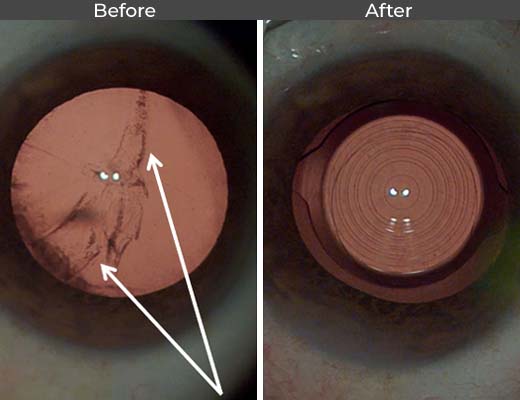
Cortical Spoking Cataract with mild Epiretinal membrane with Odyssey Premium Lens
Cortical Spoking Cataract with mild Epiretinal membrane with Odyssey Premium Lens
This 58-year-old real estate agent had developed Cortical Spoking (CS) cataracts (before image), decreasing her vision over time. She was struggling with seeing signs in the distance and with increasing glare when out in the sun. She was also having difficulty reading on her computer (due to glare, farsightedness, and presbyopia). On examination, she also had a stable mild Epiretinal Membrane (ERM- scarring over the central retinal surface), which was not affecting her vision.
She sought to achieve excellent distance, intermediate, and near vision. Based on her lifestyle needs, her pupil size in bright light, her ERM, and her corneal shape, our EAGLE Vision Algorithm recommended an Odyssey Intraocular Lens (after image) to provide her with binocular vision and independence from glasses for distance, intermediate, and near.
Some of the previously developed diffractive intraocular lens technology platforms reduce contrast sensitivity (colors appear slightly washed out), especially when there is an additional ocular disease (ex. ERM or Glaucoma). The Odyssey intraocular lens, however, does not affect contrast acuity. Therefore, in eyes with stable early ocular disease (besides just cataracts), the lens’s contrast acuity performance appears to approach that of a monofocal lens (single vision lens).
-
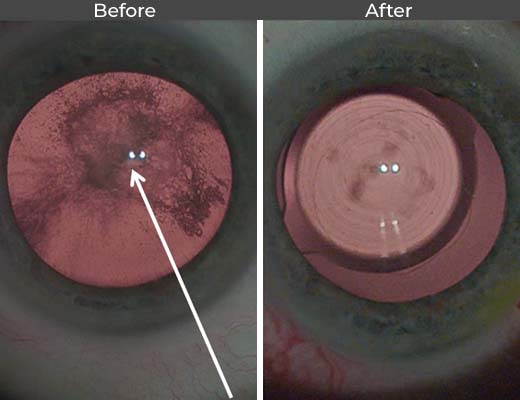
Posterior Subcapsular Cataract with Odyssey Premium Lens
Posterior Subcapsular Cataract with Odyssey Premium Lens
This 63-year-old accountant developed a Posterior Subcapsular (PS) cataract (before Image) after recovering from pneumonia, which was treated with long-term oral steroids. He noted a shift in his vision within a short time frame, which was not correctable with glasses or contact lenses, and he noticed a disabling glare from headlights.
After discussing his visual goals of becoming independent of his computer glasses and still retaining excellent distance vision for playing golf, our EAGLE Vision Algorithm determined that he would be a great candidate for Odyssey lenses (after Image) based on his pupil size in bright light, corneal shape, and lifestyle needs.
-
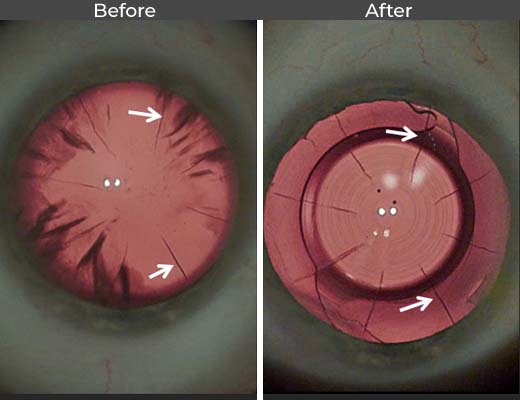
Cortical Spoking and Radial Keratectomy with Odyssey Premium Lens
Cortical Spoking and Radial Keratectomy with Odyssey Premium Lens
This 71-year-old male who presented with Cortical Spoking (CS) cataracts (before image), had undergone 8-incision Radial Keratotomy (RK) (arrows) many years earlier, to treat his high degree of nearsightedness. His main struggle was now at nighttime due to the increased glare from headlights of oncoming traffic being scattered off the CS pattern lens opacities. He aimed to reduce his dependency on eyeglasses and Rigid Gas Permeable (RGP) hard lenses.
Our Eagle Vision Algorithm determined that he would be a great candidate for Odyssey lenses (after image) due to the unique design of this IOL, which pairs it well nicely with an eye that had prior corneal refractive surgery for nearsightedness. This is because the Odyssey lens offsets the corneal shape change and associated optical distortion following refractive surgery without compromising contrast acuity in such patients.
In addition, our Enriched optics Algorithm determined that the Odyssey lens would serve as his best choice, with the selected lens power further refined during surgery (after the cataract is removed), using the Aberrometry Guided (ORA) System, which we launched in 2007. Real-time Aberrometry Guidance is especially important for proper lens style and power selection in eyes with prior corneal surgery (transplants, Lasik, PRK, Radial Keratotomy, etc.) as the traditional ultrasonic measurement systems are not highly accurate in such eyes.
-
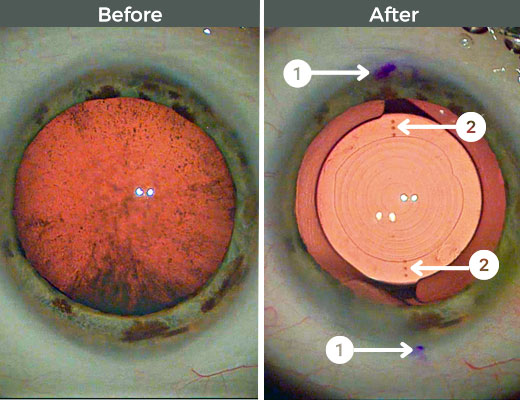
Variable Pattern Cataracts with Symfony Optiblue Toric IOL
Variable Pattern Cataracts with Symfony Optiblue Toric IOL
A 93-year-old patient had variable pattern (extremely hardened) cataracts and early retinal aging changes (precursor to macular degeneration). He also had substantial Astigmatism. Our Enriched Optics Algorithm predicted the Symfony Optiblue Toric IOL was his lens of choice. This lens demonstrates superb contrast acuity (desirable in the face of mild retinal changes), especially when the pupil can become small after surgery.
Once the cataract was removed, we further treated the Astigmatism by using our developed real-time Aberrometry Guided system to pinpoint the exact astigmatism orientation (“axis”) on the eye (then marked using a blue dye marker (see number 1).
After the Symfony Optiblue Toric lens is through a tiny self-sealing 2.2mm opening), the lens is rotated into the proper position by aligning its peripheral hash dots (see number 2) with the Aberrometry Guided (pre-placed) blue markings.
Once the lens has settled into position, our measurement is repeated to confirm the perfect position. Our proprietary Enriched Optics Algorithm and our developed Aberrometry Guidance are two pillars of our EAGLE Vision cataract offering.
-

Cortical Spoking and Oil Droplet Cataract with Vivity Lens
Cortical Spoking and Oil Droplet Cataract with Vivity Lens
A 53-year-old Fireman with both Cortical Spoking [1] and Oil Droplet pattern cataract. Both of these types of opacity scatter incoming light rays, resulting in glare (especially at night, when the pupils enlarge). In this case, it was making it more difficult to drive the fire truck at night.
A Vivity model, Extended Depth of Focus, glare minimizing Intraocular Lens (IOL) replaced the cataract to optimize both night vision and far distance vision. This was the ideal lens selection for him as he has large pupils in the dark and yet small pupils in bright light.
-

Post Radial Keratotomy (RK) Eye with Water Vacuole Cataract treated with Tecnis Eyhance Toric Lens
Post Radial Keratotomy (RK) Eye with Water Vacuole Cataract treated with Tecnis Eyhance Toric Lens
64-year-old who underwent corneal Radial Keratotomy (RK) [1] in 1990 to correct nearsightedness and has recently developed a cataract. This form of lens opacity is referred to as a “Water Vacuole” or “Oil Droplet” [PLACE ARROW TO AN OIL DROPLET AND LABEL AS 2]. Classic symptoms are blurred vision, glare, and “ghosting.” The patient also had astigmatism (warpage in eyes focusing system that blurs vision at all distances) and wished to see very clearly at distance and intermediate with minimal glare.
Our Enriched Optics Algorithm selected Intra Ocular Lens (IOL) was a Tecnis Eyhance Toric (Astigmatism correcting) as this Extended Depth of Focus (EDOF) lens has a steepened curvature (asphericity), which nicely complements the eye’s extremely flattened post-RK cornea - the two lenses working well together to provide the clearest vision. The small diameter pupil, coupled with the Lens’ inherently increased focal depth, enables this patient to see well at both near and distance following the surgery - and with minimum glare (despite the old RK incisions). The astigmatism was corrected using a laser measurement system (Ora), which we originally developed and performed the world's first cases with. This device enables us to pinpoint the exact orientation of the eye’s astigmatism [arrow 3 pointing to blue markings] for precise alignment with the IOL’s correcting axis, denoted by the pre-etched dot [arrow 4].
-
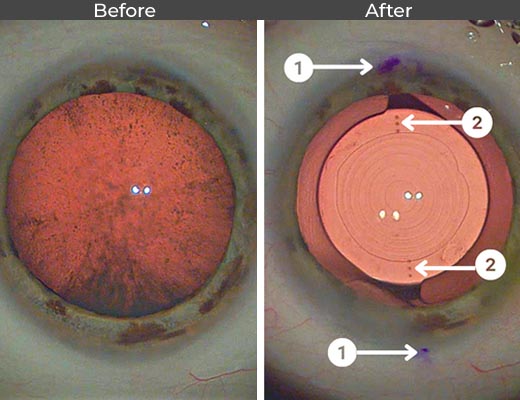
Cataract patient before and after picture #8
Variable pattern cataract with Symfony Optiblue Toric lens
A 93-year-old patient with variable pattern lens opacities and extremely hardened cataracts. The cataract hardening is referred to as nuclear sclerosis (NS), which appears as a diffuse central opacification that blocks incoming light. NS is an aging change of the lens and the most common type of cataract. He also had very early retinal aging changes (a possible precursor to macular degeneration) and a large amount of Astigmatism (optical warpage within the eye’s focusing mechanism). Our Enriched optics Algorithm singled out the Symfony Optiblue Toric IOL as the best lens choice for this eye. This lens demonstrates superb contrast acuity (desirable in the presence of mild retinal changes), especially when the pupil is either naturally small or can be made to become small after surgery.
We further treated the Astigmatism by using our developed real-time Aberrometry Guided system called the ORA. Once the cataract is out of the eye and can no longer confuse power measurements, the ORA’s laser imaging system pinpoints the exact astigmatism orientation (“axis”) on the eye, which is then marked using a blue dye marker [1]. After the Symfony Optiblue Toric lens is entered into the eye (through just a tiny self-sealing 2.2mm opening), the lens is rotated into the proper position by aligning its peripheral hash dots [2], with the Aberrometry Guided (pre-placed) blue markings. Once the lens has settled into position, the Aberrometry measurement is repeated to confirm the perfect position or to guide a small Lens rotation.
Our proprietary Enriched Optics Algorithm, coupled with our developed Aberrometry Guidance, serve as two of the pillars in our EAGLE (Enriched optics Aberrometry Guided Lenticular Exchange) Vision cataract offering.
-

Posterior Sub-Capsular (PSC) Cataract, with Extended Depth of Focus (EDF), Toric IOL
Posterior Sub-Capsular (PSC) Cataract, with Extended Depth of Focus (EDF), Toric IOL
A young patient with asthma using chronic steroid inhalers, now with a Posterior Sub-capsular (PSC) cataract. This form of cataract is more often seen in people with Diabetes following prolonged steroid use, injury, and ocular inflammation. It behaves as its appearance may suggest - like ground glass sprayed onto a window - causing visual blur and disabling glare. Based upon the patient’s young age and active lifestyle, coupled with their flattened corneal shape, pupil size, high degree of nearsightedness, and prominent astigmatism, our Enriched optics Algorithm recommended the use of an Intraocular Lens (IOL) possessing an Extended Depth of Focus (EDOF - to expand range of focus), a highly elevated front surface central curvature (to offset the flattened corneal shape), along with astigmatic correcting capability.
We thus treated the Astigmatism by using the Ora, real-time Aberrometry Guided system (originally developed by us in 2007). With this system, once the cataract is out of the eye and can no longer confuse power measurements, the Ora laser measuring device pinpoints the exact astigmatism orientation (“axis”) on the eye (which we then mark using a blue dye marker [1]. After the Toric ( astigmatism correcting) EDOF lens is entered into the eye (through a tiny opening), the lens then unfolds (like a newspaper) and is rotated into the proper position by aligning its peripheral hash dots [1] to coincide with the Aberrometry Guided (pre-placed) blue markings. Once the lens has settled into position, the Aberrometry measurement is repeated to confirm the perfect position or to further guide any needed minor rotation.
Our proprietary Enriched Optics Algorithm, coupled with our previously developed Aberrometry Guidance system, serve as two of the pillars in our EAGLE (Enriched Optics Aberrometry Guided Lenticular Exchange) Vision-correcting cataract offering.
-

Cortical Spoking Cataract with Vivity IOL
Cortical Spoking Cataract with Vivity IOL
This 64-year-old executive, who enjoys race car driving, had developed Cortical Spoking (CS) cataracts [see arrow 1], with associated glare in bright lights or headlights. He was slow, having difficulty seeing the dials on the dashboard (due to farsightedness and presbyopia). He sought to achieve excellent distance and strong intermediate vision along with a significant reduction of his glare symptoms. Based on his lifestyle needs, his pupil size in bright light, and his corneal curvature, our EAGLE Vision Algorithm recommended a Vivity Lens.
-
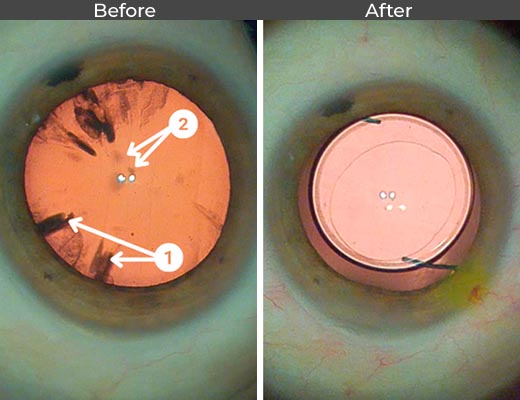
Mixed Pattern Cataract with Sensar IOL
Mixed Pattern Cataract with Sensar IOL
This 71 yo mail clerk had developed 3, types of opacity in her cataract: Nuclear Sclerosis (most frequent opacity showing up as a diffuse central lens discoloration), Cortical Spoking (CS - See Arrow 1), and Oil Droplets (see arrow 2). The combination of opacities greatly reduced her vision despite eyeglasses (even when correcting for near, far, and astigmatism), for which he sought a remedy. For both economic considerations and not minding eyeglasses for both near and distance, she opted for a standard IOL and was provided with a Sensar lens.
-

Posterior Subcapsular Cataract with Envista Toric Lens
Posterior Subcapsular Cataract with Envista Toric Lens
This 69-year-old female engineer had developed a posterior sub-capsular (PSC) [arrow 1] cataract and wished to have superb glare-free distance vision and wear magnifiers for her myriad of near work.
She had large pupils (making glare a bigger challenge) and centrally steep-shaped corneas from prior Hyperopic PRK (for a high amount of farsightedness). She also had the early stages of a membrane growing over the retina (Epi-Retinal Membrane - ERM) Our EAGLE algorithm selected the Engista Toric IOL as the best lens selection for her. This single vision, astigmatism correcting lens produces minimum glare and nicely compliments her very steep corneas (as it has a very flat asphericity profile, offsetting the steep corneal shape). This combination provides her with the sharpest and most glare-free distance vision while necessitating magnifiers for intermediate and near viewing.
-

Post Vitrectomy for Retinal detachment repair, with a Diffractive Optic, Toric Lens
Post Vitrectomy for Retinal detachment repair, with a Diffractive Optic, Toric Lens
A 44-year-old who had undergone successful retinal detachment repair with excellent preservation of central vision. As a consequence of the retinal surgery, the patient developed a dense cataract, which included the outermost surface of the lens (lens capsule [see arrow 1] ). As the cataract is removed, the outer capsule is left intact to serve as a scaffold for the newly placed lens. The leftover scar will later be polished clean by an infrared (YAG) laser to create a clear pathway for incoming light.
A diffractive pattern multifocal lens [see arrow 2 pointing to defective rings] with astigmatism correction capability (Toric) was used, as the patient wished to be independent from glasses for both near and far. In order to most precisely treat astigmatism, our EAGLE Vision platform enlists the Ora Aberrometer, which measures astigmatism throughout the procedure and guides our rotation of the lens into the optimal axis - by aligning the lens astigmatic correcting axis denoted by the dotted etchings [see arrow 3], with the Ora measured eye astigmatism axis (denoted by blue ink marking on the eye [see arrow 4]
-
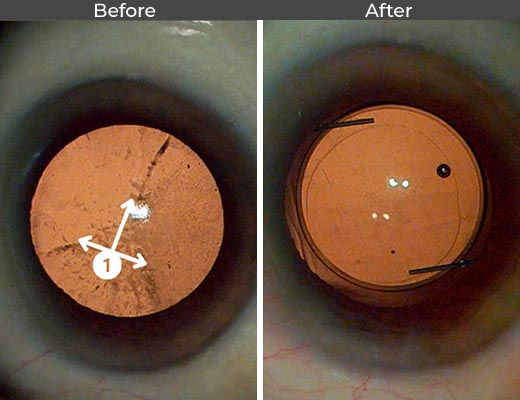
Mixed cataract and Sensar Lens
Mixed cataract and Sensar Lens
This 63-year-old architect has both cortical spoking (arrow 1), which causes incoming light to scatter with resultant glare, and also a nuclear sclerotic cataract, which discolors the lens and blurs vision. He also has large pupils and early aging of the retina, referred to as Dry Age-Related Macular Degeneration (Dry AMD).
Based upon his pupil size, corneal curvature, and retinal condition (AMD), and his desire for the sharpest possible distance vision, our EAGLE Vision Algorithm recommended the Sensar lens.
-
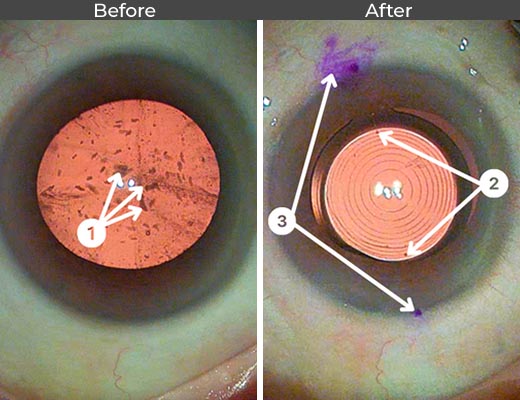
Oil Droplet cataract and Symfony Toric Lens
Oil Droplet cataract and Symfony Toric Lens
This patient was experiencing extreme glare from both daytime (sun light) and nighttime (headlight) sources. The glare was due to the nature of her cataracts, which are focal opacities referred to as Water Vacuole and Oil Droplets [see arrow 1]. Light scatters wildly off of these focal opacities, which can create tremendous back glare, making many activities (including driving) extremely challenging.
The patient wished to be free from both the glare and from their eyeglasses which were being used for both near and distance. Based upon these desires, their underlying astigmatism and their pupil diameter, our EAGLE Vision algorithm recommended the Symfony Optiblue Toric lens for optimal quality vision and with astigmatism correction capability.
In order to most precisely treat astigmatism, our EAGLE Vision platform enlists the Ora Aberrometer, which measures astigmatism throughout the procedure and guides our rotation of the lens into the optimal axis - by aligning the lens astigmatic correcting axis denoted by the dotted etchings [see arrow 2], with the Ora measured eye astigmatism axis (denoted by blue ink marking on eye [see arrow 3].
-
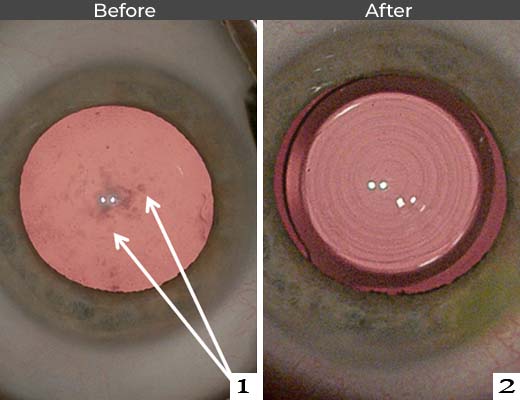
Nuclear Sclerotic and oil droplet Cataract and Odyssey Lens
Nuclear Sclerotic and oil droplet Cataract and Odyssey Lens
This 67-year-old woman presented to our office with a gradual increase in her eyeglass prescription as she became progressively more nearsighted due to Nuclear Sclerotic (NS) cataracts, as such a cataract, in addition to serving as an opacity within the natural lens of the eye, also alters the shape of that lens, making the eye more nearsighted.
Her lens opacities also included Oil Droplet opacities (vacuoles within the lens in the before image), which scatter incoming light. She thus struggled primarily in dim lighting conditions and towards the evening at dusk (due to the diffuse Nuclear Sclerosis opacity) and when looking towards the sun (due to the scattered Oil droplet opacities).
While she appreciated her decreased reliance on her reading glasses due to her increased myopia (nearsightedness), she sought to improve her distance vision again. Based on our EAGLE Vision Algorithm and her lifestyle needs, we corrected her distance, intermediate, and near vision with Odyssey lenses (after Image).

.jpg)

.jpg)



.jpg)





























